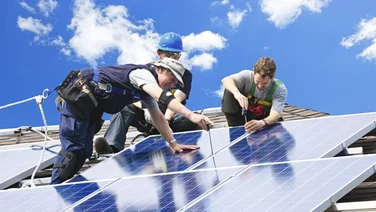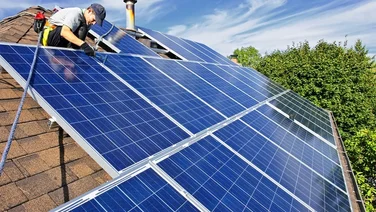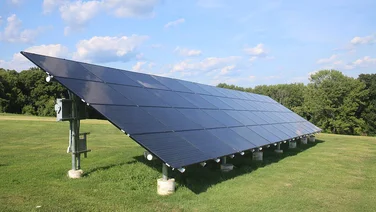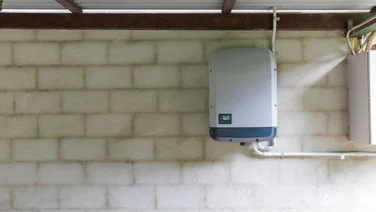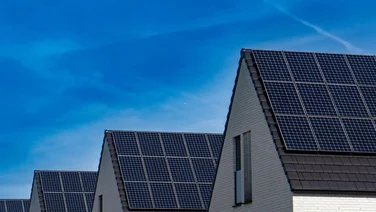✔ 1.3 million UK homes have solar panel installations
✔ That’s 4.1% of the UK’s 29 million homes generating electricity from solar
✔ The UK is among the top 12 countries for solar power capacity
Solar panels might not seem an obvious choice in the UK, but they can still work well with only a small amount of sunlight – and given solar panel costs have decreased by 82% since 2010, there’s never been a better time to make the switch.
That’s why a good number of Brits have adopted the technology – but how many, exactly?
Below, we’ll be looking at the number of people in the UK with solar panels, discussing whether solar panels’ popularity is expected to increase, and investigating how the UK compares to the rest of the world.
Where do you want to install solar panels?
Get started
How many people have solar panels in the UK?
There are more than a million solar panel installations in the UK.
Homeowners worried about solar panels reducing their property’s attractiveness can rest easy too, with our latest National Home Energy Survey showing 69% of people are likely or very likely to buy or rent a property with solar panels.
Let’s look at the numbers of both residential and commercial properties using solar panels.
Residential
There are more than 1.3 million UK homes with solar panel installations, according to the latest MCS data. This means 4.1% of the 29 million homes in the UK are generating electricity from solar panels. There’s definitely room for improvement here.
Still, these stats show a huge uptick from where solar panels were just over a decade ago. In 2008, solar panels accounted for just one megawatt of electricity generation in England, including solar panels on the Isle of Wight.
By 2020, solar panels were responsible for an astonishing 11,730 megawatts throughout the country.
This trend is much the same across the UK’s other regions, with Scotland, Wales, and Northern Ireland all seeing huge increases in the energy generated in homes by solar power.
Commercial
‘Commercial solar’ describes large-scale operations using solar power, such as in agriculture or manufacturing. ‘Business solar’ describes small and medium-sized businesses (SMEs) using solar power, such as a corporate office or any enterprise with limited space for solar installations.
When we talk about commercial solar then, we need to look at the large-scale solar installations in the UK. A good example of this is solar farms, which are large plots of land filled with solar panels that generate electricity either for nearby villages, towns, and cities, or agricultural/industrial operations.
As of 2020, there are just under 500 solar farms operating in the UK. These are the five largest:
- Shotwick solar park – 250 acres, 72.2 megawatts peak
- Lynham solar farm – 213.3 acres, 69.8 megawatts peak
- Owl’s Hatch solar park – 212 acres, 51.9 megawatts peak
- Wroughton Airfield solar park – 165 acres, 50 megawatts peak
- West Raynham solar farm – 225 acres, 49.8 megawatts peak
You might also like: 13 Solar Panel Facts.
How has this number changed over time?
Prior to 2010, the number of solar installations was progressing at a snail’s pace. This was down to many things, including poor return on investment, lack of government subsidies, and the high cost of solar panels themselves.
Since 2010, the number of solar panel installations has increased dramatically. This uptick is thanks to initiatives such as a feed-in tariff, which paid out a certain amount for every kWh of solar energy generated and every kWh of solar energy sent back to the grid.
This scheme has unfortunately stopped now, but during its run it definitely helped increase the number of homeowners getting solar panels installed. To give you some idea of just how much installations have increased, take a look at the table below:
Where do you want to install solar panels?
Get started
Do we expect it to increase?
Despite the table above suggesting that solar panel installations are slowing down, we still expect a continual increase in the number of people getting them. One obstacle, though, is that the UK government has ended the feed-in tariff subsidy for solar panels, meaning they’ve become less cost effective.
This decision came under significant criticism, and rightly so – the Labour Party said in 2019 that as a result of the subsidy ending, new solar panel capacity fell from 79 megawatts to just 5 megawatts.
Why do we still believe that solar panel installations will increase, then? Even though the UK government has made it more difficult, a growing ‘eco-conscience’ is pushing people to turn to renewable energy from sources like solar panels.
For instance, 62% of people want the government to replace gas with green energy, according to our National Home Energy Survey.
And despite the feed-in tariff subsidy ending, the falling overall cost of solar is making it easier to buy and install panels outright.
What is the total solar panel capacity in the UK?
The UK is currently producing 13,258 megawatt hours of electricity per year, which is able to power around three million homes across the country. This is a big increase over the 5,488.6 megawatt hours produced in 2014. There is some concern that solar panel capacity stalled in 2020, but as the IEA has made clear, the COVID-19 pandemic definitely had an impact.
As the pandemic abates however, the UK is expected to continue to increase solar panel capacity in line with its drive to reach net zero by 2050. In fact, the IEA also projects the UK’s solar panel capacity to nearly triple by 2030.
This would reduce UK emissions by a significant 4.7%. Whilst that might not sound huge, in the context of a wider adoption of renewable energy sources it is still substantial.
How does the UK’s solar power capacity compare to the rest of the world?
The UK remains a leader in shifting away from fossil fuels, and its continued adoption of solar panels is impressive – but how exactly does it stack up against the rest of the planet?
Using available data from the International Renewable Energy Agency (IRENA), the UK currently sits in 11th place for renewable energy generation. That’s behind three other European countries – Spain, Italy, and Germany (in 10th, 6th, and 4th places respectively), with Germany in particular eclipsing the UK’s solar capacity by a lot (at 53,783 megawatt hours produced per year).
Here are the top 12 countries by solar capacity:
| Country | Installed capacity, megawatts | Watts per capita | % of world total |
| China | 254,355 | 147 | 35.6% |
| U.S. | 75,572 | 231 | 10.6% |
| Japan | 67,000 | 498 | 9.4% |
| Germany | 53,783 | 593 | 7.5% |
| India | 39,211 | 32 | 5.5% |
| Italy | 21,600 | 345 | 3.0% |
| Australia | 17,627 | 637 | 2.5% |
| Vietnam | 16,504 | 60 | 2.3% |
| South Korea | 14,575 | 217 | 2.0% |
| Spain | 14,089 | 186 | 2.0% |
| United Kingdom | 13,563 | 200 | 1.9% |
| France | 11,733 | 148 | 1.6% |
Source: IRENA (2021)
Outside of Europe, you have Japan and the United States in 3rd and 2nd place. Japan sits at a solar panel capacity of 67,000 megawatts, while the US has an impressive 75,572 megawatts capacity (though considering the sheer size of the US, you could argue it’s not as impressive as it perhaps could be).
All these countries absolutely pale in comparison to the biggest hitter in the solar panel game: China. The world’s most populous nation has a staggering 254,355 megawatts capacity, accounting for 35% of the world’s global solar panel capacity.
Of course, the caveat is that China continues to lead a less-than-flattering statistic – that of the world’s worst polluter. Its carbon emissions make up 30% of all global emissions, which is more than double the next big polluter, the US.

